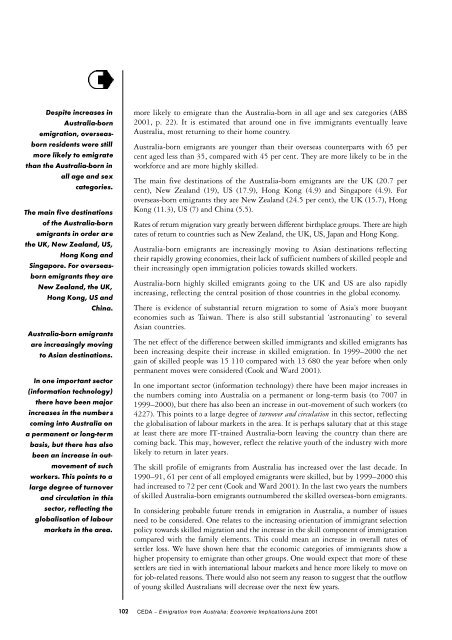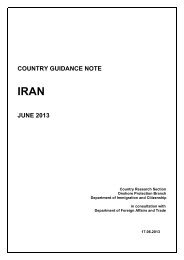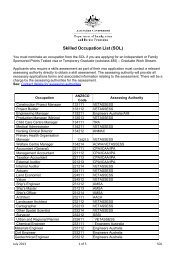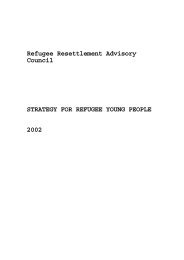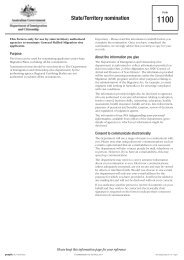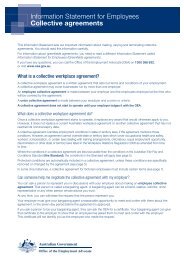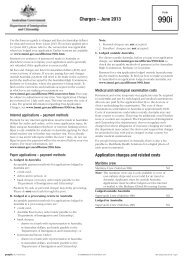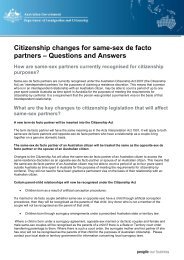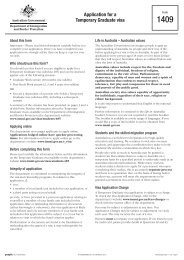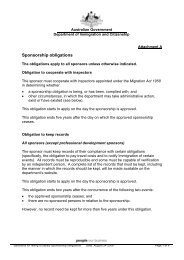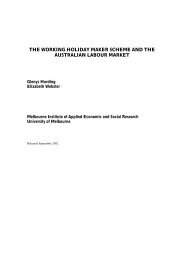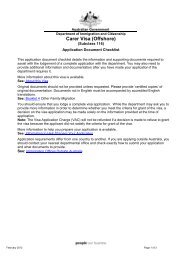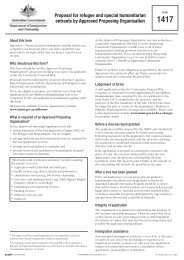part three - Department of Immigration & Citizenship
part three - Department of Immigration & Citizenship
part three - Department of Immigration & Citizenship
You also want an ePaper? Increase the reach of your titles
YUMPU automatically turns print PDFs into web optimized ePapers that Google loves.
Despite increases in<br />
Australia-born<br />
emigration, overseasborn<br />
residents were still<br />
more likely to emigrate<br />
than the Australia-born in<br />
all age and sex<br />
categories.<br />
The main five destinations<br />
<strong>of</strong> the Australia-born<br />
emigrants in order are<br />
the UK, New Zealand, US,<br />
Hong Kong and<br />
Singapore. For overseasborn<br />
emigrants they are<br />
New Zealand, the UK,<br />
Hong Kong, US and<br />
China.<br />
Australia-born emigrants<br />
are increasingly moving<br />
to Asian destinations.<br />
In one important sector<br />
(information technology)<br />
there have been major<br />
increases in the numbers<br />
coming into Australia on<br />
a permanent or long-term<br />
basis, but there has also<br />
been an increase in outmovement<br />
<strong>of</strong> such<br />
workers. This points to a<br />
large degree <strong>of</strong> turnover<br />
and circulation in this<br />
sector, reflecting the<br />
globalisation <strong>of</strong> labour<br />
markets in the area.<br />
more likely to emigrate than the Australia-born in all age and sex categories (ABS<br />
2001, p. 22). It is estimated that around one in five immigrants eventually leave<br />
Australia, most returning to their home country.<br />
Australia-born emigrants are younger than their overseas counter<strong>part</strong>s with 65 per<br />
cent aged less than 35, compared with 45 per cent. They are more likely to be in the<br />
workforce and are more highly skilled.<br />
The main five destinations <strong>of</strong> the Australia-born emigrants are the UK (20.7 per<br />
cent), New Zealand (19), US (17.9), Hong Kong (4.9) and Singapore (4.9). For<br />
overseas-born emigrants they are New Zealand (24.5 per cent), the UK (15.7), Hong<br />
Kong (11.3), US (7) and China (5.5).<br />
Rates <strong>of</strong> re t u rn migration vary greatly between diff e rent birthplace groups. There are high<br />
rates <strong>of</strong> re t u rn to countries such as New Zealand, the UK, US, Japan and Hong Kong.<br />
Australia-born emigrants are increasingly moving to Asian destinations reflecting<br />
their rapidly growing economies, their lack <strong>of</strong> sufficient numbers <strong>of</strong> skilled people and<br />
their increasingly open immigration policies towards skilled workers.<br />
Australia-born highly skilled emigrants going to the UK and US are also rapidly<br />
increasing, reflecting the central position <strong>of</strong> those countries in the global economy.<br />
T h e re is evidence <strong>of</strong> substantial re t u rn migration to some <strong>of</strong> Asia’s more buoyant<br />
economies such as Taiwan. There is also still substantial ‘astronauting’ to several<br />
Asian countries.<br />
The net effect <strong>of</strong> the difference between skilled immigrants and skilled emigrants has<br />
been increasing despite their increase in skilled emigration. In 1999–2000 the net<br />
gain <strong>of</strong> skilled people was 15 110 compared with 13 680 the year before when only<br />
permanent moves were considered (Cook and Ward 2001).<br />
In one important sector (information technology) there have been major increases in<br />
the numbers coming into Australia on a permanent or long-term basis (to 7007 in<br />
1999–2000), but there has also been an increase in out-movement <strong>of</strong> such workers (to<br />
4227). This points to a large degree <strong>of</strong> turnover and circulation in this sector, reflecting<br />
the globalisation <strong>of</strong> labour markets in the area. It is perhaps salutary that at this stage<br />
at least there are more IT-trained Australia-born leaving the country than there are<br />
coming back. This may, however, reflect the relative youth <strong>of</strong> the industry with more<br />
likely to return in later years.<br />
The skill pr<strong>of</strong>ile <strong>of</strong> emigrants from Australia has increased over the last decade. In<br />
1990–91, 61 per cent <strong>of</strong> all employed emigrants were skilled, but by 1999–2000 this<br />
had increased to 72 per cent (Cook and Ward 2001). In the last two years the numbers<br />
<strong>of</strong> skilled Australia-born emigrants outnumbered the skilled overseas-born emigrants.<br />
In considering probable future trends in emigration in Australia, a number <strong>of</strong> issues<br />
need to be considered. One relates to the increasing orientation <strong>of</strong> immigrant selection<br />
policy towards skilled migration and the increase in the skill component <strong>of</strong> immigration<br />
c o m p a red with the family elements. This could mean an increase in overall rates <strong>of</strong><br />
settler loss. We have shown here that the economic categories <strong>of</strong> immigrants show a<br />
higher propensity to emigrate than other groups. One would expect that more <strong>of</strong> these<br />
settlers are tied in with international labour markets and hence more likely to move on<br />
for job-related reasons. There would also not seem any reason to suggest that the outflow<br />
<strong>of</strong> young skilled Australians will decrease over the next few years.<br />
102 C E DA – Emigration from Australia: Economic ImplicationsJune 2001


